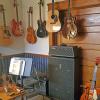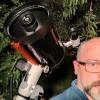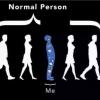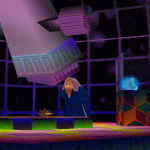
Tracking...
#1

Posted 30 August 2013 - 04:47 PM
#2

Posted 30 August 2013 - 04:49 PM
#3

Posted 31 August 2013 - 12:30 AM
This sounds like expected behavior. I don't believe the CG4 autoguides, so you must be doing unguided tracking. Your longest exposure will depend not only on the CG4, but on the accuracy of your polar alignment, the focal length of your lens or telescope, and the size of the pixels in your camera.
To get pinpoint stars for all of your images use a wide angle lens. If you use a somewhat longer focal length lens you will get the behavior you described due the the periodic error of of the mount. Instead of going at a constant speed it will alternately slow down and speed up, but briefly the speed will be correct.
Do some experiments to discover the longest focal length lens you can use to achieve 200-300 second exposures. For the longer focal lengths try to find an exposure length where half of your images are good and discard the rest.
Good luck,
Gale
#4

Posted 31 August 2013 - 09:36 AM
#5

Posted 31 August 2013 - 10:00 AM
Unless you install a Radial Guider and use a dual cross hair reticule eyepiece and manually guide the mount, the best tracking you can achieve with this mount will never give you the exposure lengths you want. And quite honestly, I seriously doubt you could manually guide for 5 full minutes and get perfectly round stars anyway...
The bottom line is, you need a better mount.
And, if you are using a Newtonian reflector, you are going to get field rotation.
#6

Posted 31 August 2013 - 10:16 AM
See http://www.store.sho...products_gp.htm
Even so may be inadequate for the lenghy exposures you are seeking. You are best off using camera lenses for long exposures with a CG4. Since you are having some luck with 90 second exposures I would stick with 30-60 second exposures with the reflector. Use DSS (Deep Sky Stacker) software to to stack multiple short exposures to allow longer integration times.
For more pleasing results you will need a larger and more precise mount.
Edit:
For an idea of what is possible with the CG4, go to www.astrobin.com and do an Advanced Search for CG4. There you will find some examples of unguided images of galaxies and nebula using 6" reflectors and small refactors. All of the images were taken by stacking 30-90 second exposures. I was surprised by how good some of them were. You will see some star enlongation at full resolution on many of them, but the look good when reduced to 25% to 50% size (which you need to do anyway to avoid bloated stars).
Gale
#7

Posted 31 August 2013 - 11:04 AM
The reason you get a good frame then a bad, then a good, i think, is the periodic error in the worm gear. So if you can get a good 90 sec frame out of 3 then I would say that's your best. The only way to get longer without tremendous frustration is to not use the scope. Just mount the camera on there and use a 50mm lens, you should be able to get 300 sec subs with good round stars.Or in other words what's the maximum exposure time I can go before the star drifts....I'm willing to hear everything....
#8

Posted 01 September 2013 - 01:26 PM
#9

Posted 01 September 2013 - 01:31 PM
For reference, without an H-a filter I would saturate my camera is 2-3 minute exposures. With an H-a filter I can go 20 minutes - that's 1200 seconds - and the histogram is only 1/3 of the way from the left.
I never thought anyone would try to do narrowband imaging with a mount in this class... also a DSLR will have tremendous noise with the long exposures you'd need for narrowband.
Then again. Here's an H-alpha on a modest mount. But it was done with a 50mm lens. And a cooled camera was used to get the long exposures.
http://www.flickr.co...N00/4296782609/
#10

Posted 01 September 2013 - 01:37 PM
http://stargazerslou...50mm-widefield/
And this guy used a CG-4 with a Canon DSLR.
http://www.astrobin.com/32336/B/
60 x 60 seconds with a 50mm lens. At which focal length guiding is not needed.
#11

Posted 01 September 2013 - 01:41 PM
90- to 300-second exposures in my opinion won't get you anything with an H-a filter. 600 seconds minimum..
On an Ha-rich target I sometimes get away with 5 minutes plus a lot of extra processing - but certainly no less than that. And forget short-exposure SII - it requires much longer exposures than Ha. I usually see no SII nebulosity at all in ten minutes.
#12

Posted 01 September 2013 - 02:22 PM
#13

Posted 01 September 2013 - 02:27 PM
#14

Posted 01 September 2013 - 02:32 PM
#15

Posted 01 September 2013 - 02:53 PM
The PE was quite good, manageable, most of the time. However there was one bad spot, I can still remember those terrible moments as I fruitlessly tried to guide away the error but I just couldn't keep up..
Jon
#16

Posted 01 September 2013 - 03:35 PM
#17

Posted 01 September 2013 - 06:59 PM
I still got to say - I never tried narrowband with my CGEM that I used to have. I'm that paranoid.
#18

Posted 01 September 2013 - 07:44 PM
#19

Posted 01 September 2013 - 08:04 PM
I was able to do 2-minute unguided exposures with a 50mm lens, and results weren't too bad. Now these are not H-a (just plain unfiltered) but with a good polar alignment I don't see how you can't do 4-5 minutes.

I used a Pentax K20D (a fairly noisy DSLR by today's standards) and a Vixen Polaris, which is the original mount from which the CG-4 was copied. Only an eyeball polar alignment, no guiding or anything. You can see the Horsehead and Flame Nebulas (faintly) in the above photo. 50mm f/2 manual focus lens at f/4 I believe. You could get a bigger image if you used a 100mm f/2 Canon lens.
#20

Posted 01 September 2013 - 09:06 PM
Like stated above... use a short fast lens like a 50/1.8 or 100/2 (the fast focal ratio will mean you can shoot shorter exposures, and the short focal length will mask tracking errors).
I was able to do 2-minute unguided exposures with a 50mm lens, and results weren't too bad. Now these are not H-a (just plain unfiltered) but with a good polar alignment I don't see how you can't do 4-5 minutes.
Or, if your mount is not up to 4 minute exposures for the focal length you want to image at, just take twice as many 2 minute exposures. That normally works for photos like Orlyandico took without the Ha filter. With the Ha filter you will be filtering out more LP and also a lot of the stars. I suspect the 20 minute exposures are to make the stars bright enough that the stacking software can align the images (Hey guys, am I right on that?).
Gale
#21

Posted 02 September 2013 - 08:45 AM
#22

Posted 02 September 2013 - 11:50 AM
Obviously if your lens is at f4 you'd only need (7/4)^2 = 3 = one third of the time (e.g. 3.33 minutes).
And at f2 (the widest a 100mm f/2 lens will go) you'd only need (7/2)^2 = 12X less time, thus 2 minutes would work.
So if you can get your hands on a 100mm f/2 lens it might still be worth your while to check if the filters work.
#23

Posted 02 September 2013 - 12:19 PM
#24

Posted 04 September 2013 - 04:29 PM
#25

Posted 04 September 2013 - 06:07 PM
i want to do the 200-300 second exposures so what mount would do that for me?
Guided or unguided? What focal length? How much payload?























